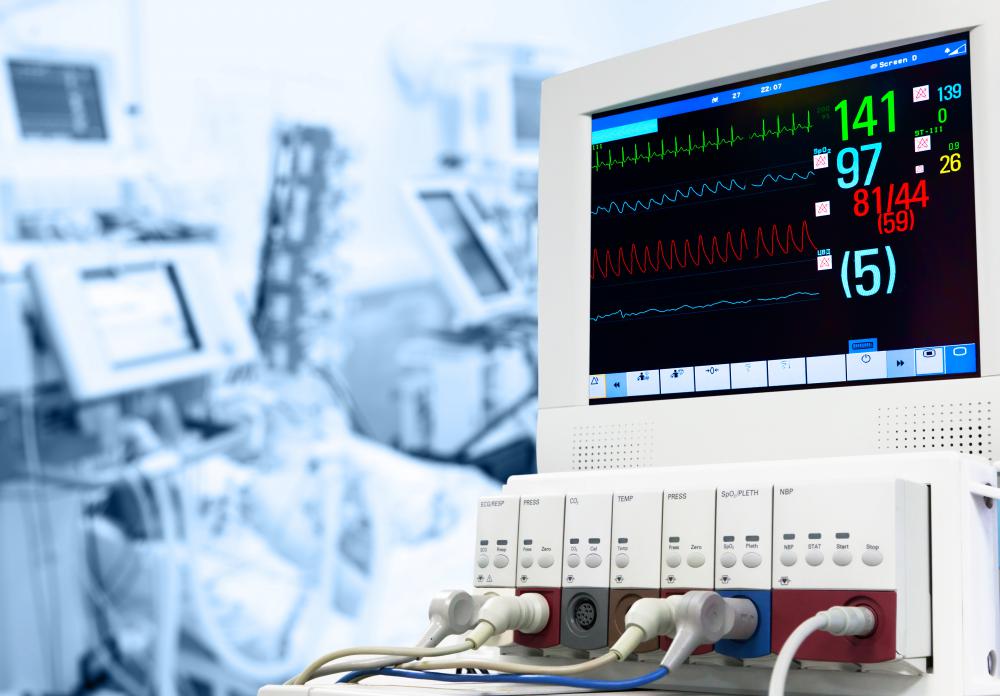At WiseGEEK, we're committed to delivering accurate, trustworthy information. Our expert-authored content is rigorously fact-checked and sourced from credible authorities. Discover how we uphold the highest standards in providing you with reliable knowledge.
What is a Medical Monitor?
A medical monitor could be any machine, small or large, most often powered by plug/electricity or battery that gives readings of some function or aspect of the body. These readings may prove helpful in determining healthfulness of body function. There are many types of medical monitors used in hospitals, some are seen in doctors office and some may even be used at home on a short or long-term basis to give medical workers important information that will help them make treatment decisions.
A medical monitor that might be used in a doctor’s office or hospital is a SAT monitor or pulse oximeter. Part of this is a device that looks slightly like an alligator mouth, or a small adhesive bandage when used on little kids, that is placed on the finger to gauge oxygen saturation levels. A SAT reading is delivered after a minute or two and can help determine if a person has lower than normal oxygen levels in the blood. Similar to this is the extremely common electric or battery powered thermometer, which can evaluate body temperature and look for irregularities. Many physicians also now use a blood pressure monitor powered by machine to get a more accurate reading of blood pressure. All of these monitors are used for just a few minutes in most doctors’ offices, but they might be employed for lengthier periods of time in a hospital.

Medical monitor examples in hospitals are numerous. Some machines measure things like heart rate, respiration rate, blood pressure, and oxygen saturation levels at the same time to conserve space while measuring multiple vital signs. These could be used on the severely ill or on those undergoing surgery. There are some brief use monitors that may be used diagnostically. EKG (electrocardiogram) and EEG (electroencephalogram) are often used just for a few minutes to get baseline readings regarding cardiac and brain function. However they can be used for longer periods of time if needed; for example, sleep studies often involve using EEGs for an entire night. Another example of a medical monitor is the fetal monitor used during labor and delivery, which can take many hours.

Some monitors are portable and can be taken home or worn at home to provide a more comfortable place to run tests. When people are at risk for irregular heartbeats or arrhythmia, they might wear a holter medical monitor for 24 hours, which can record any heartbeat irregularities. Some people need to wear a similar device called an event monitor for a longer period of time, if it has been difficult to record changes in heart rhythm. When any type of unusual rhythm state occurs a button is pressed on the small monitor (which can fit in a pocket or on a belt) and that unusual event is record. Often, the event can then be replayed over a telephone to a service that electronically reports findings to a physician.

Though monitors are excellent for tracking health issues of many kinds, they do have fail rates. A person’s movement during an EKG could look like an arrhythmia, pulse oximeter clips can fall off, or any other number of things may falsify readings. What this means is that monitors can’t fully replace personal observation, and this remains a vital part of medical care.
AS FEATURED ON:
AS FEATURED ON:















Discussion Comments
When you walk into a hospital room to visit someone, all of the monitors hooked up to the patient is enough to scare you. Walking into the room makes me think the person I am visiting is in really bad condition even when that is not the case.
There is a relatively new trend of thought that says hospital rooms should be more like rooms in homes and less intimidating and less gloomy. Allowing patients to have personal items brought in is a popular way to create the feel of home. I think finding a way to minimize the appearance of monitors would help a patient feel better about her or his condition as well.
I'm not saying hospitals should get rid of all medical monitors, but maybe they could make them less obvious and eliminate the ones that are not absolutely necessary.
As this article pointed out, some medical monitoring devices can be used outside of the hospital and in people's homes. Many of these devices are meant to be read by individual patients or caregivers who can relay the information to a physician. In other cases, the devices have the ability to store data that can later be downloaded and read and analyzed by medical professionals.
There is another category of home medical monitors that can transmit information remotely from a patient's home to a hospital. These machines allow doctors and other medical staff members to follow a patient's condition in real time even though the patient is not in the hospital.
Post your comments